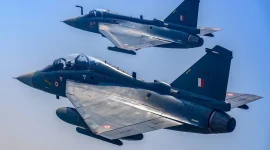- Views: 3K
- Replies: 35
Despite Moscow’s persistent offers of "deep technology transfer" to entice India back into the Su-57 Felon programme, defence experts and insiders are now firmly dismissing the proposal as outdated and strategically unnecessary.
In exclusive interactions with defence analysts, it has become clear that the argument for the Su-57—that it would accelerate India’s own fifth-generation capabilities—no longer holds water.
Experts assert that by the time any potential Su-57 deal could be operationalised, India’s indigenous Advanced Medium Combat Aircraft (AMCA) will likely have surpassed the Russian fighter in almost every critical technological aspect, barring raw weapons payload.
Diverging Trajectories: A Timeline Mismatch
Even in the unlikely event of a government-to-government agreement being signed in 2026, the logistics of production suggest a significant delay.The first Indian-assembled Su-57s, likely built from knock-down kits at Hindustan Aeronautics Limited (HAL) facilities in Nashik or Koraput, would not roll out before 2029–2030.
In contrast, the AMCA programme is adhering to a strict timeline that directly rivals this window.
The first prototype of the AMCA is scheduled for its maiden flight between late 2028 and early 2029. Following this, the first four pre-production aircraft are expected by 2031–32, with low-rate initial production commencing around 2034–35.
While the delivery timelines for both jets appear similar, their technological paths are moving in opposite directions: the AMCA is ascending towards true fifth-generation standards, while the Su-57 struggles to overcome legacy limitations.
Technological Leapfrog: Where AMCA Takes the Lead
Avionics and Sensor Fusion
The gap is perhaps most visible in avionics. The AMCA is set to feature the Uttam AESA Mk2 radar, powered by Gallium Nitride (GaN) technology and boasting over 1,400 Transmit/Receive (T/R) modules.When paired with an indigenous Integrated Sensor Suite—comprising Infrared Search and Track (IRST), Electro-Optical Targeting Systems (EOTS), and a Distributed Aperture System (DAS) offering 360-degree coverage—the AMCA’s situational awareness will be two generations ahead of the Su-57’s N036 Byelka radar and 101KS Atoll optical suite.
Electronic Warfare and Network Centricity
While the Russian platform continues to rely on external pods for electronic warfare (EW) and lacks a unified directional datalink, the AMCA is being designed as a node in a networked battlespace.It will utilise the Software-Defined Unified Datalink (SDUDL) to seamlessly share data with Rafales, Tejas Mk2s, the Twin Engine Deck Based Fighter (TEDBF), and unmanned systems. This level of integration remains absent in the Su-57's public demonstrations.
Stealth Engineering
In terms of low observability, the AMCA has been designed from the ground up for stealth.Features such as serpentine air intake ducts, a diverterless supersonic intake, and advanced Raman-scattering coatings are projected to reduce its frontal Radar Cross Section (RCS) to between -30 and -40 dBsm.
Conversely, the Su-57 has faced long-standing criticism for its semi-recessed rivets, exposed engine turbine blades, and panel gaps, which limit its stealth performance to an estimated -10 to -15 dBsm.
Propulsion and Sovereignty
Russia has frequently touted its new Izdeliye 30 (AL-51F1) engine, yet full-rate production has faced repeated delays, and the engine is not yet operational on in-service fleets.Meanwhile, India has secured a strategic path for its own propulsion needs. A 120 kN engine, jointly developed by the Gas Turbine Research Establishment (GTRE) and France's Safran, is targeted for certification by 2033–34.
Unlike the Russian offer, this deal guarantees India full control over the intellectual property.
Weapons Integration
The one area where analysts concede the Su-57 retains an edge is payload capacity. Its deeper internal bays can accommodate heavy ordnance, such as four R-37M long-range missiles.However, the AMCA’s internal bays are being optimised for next-generation Indian weapons, including the Astra Mk3 with Solid Fuel Ducted Ramjet (SFDR) technology, the Rudram anti-radiation missile series, and future smart cruise missiles.
The FGFA Ghost and Strategic Realities
Current Russian overtures are seen by many as a repackaging of the Fifth-Generation Fighter Aircraft (FGFA) project, from which India withdrew in 2018.At that time, the rationale was that 200–250 co-developed jets would teach Indian engineers the art of stealth. That logic collapsed when it became evident that Russia was unwilling to share critical source codes or stealth technology.
"In the 2010s, we needed Russia to teach us how to build a fifth-generation fighter," noted one defence analyst. "In 2025, we don’t. The only thing Russia can offer now is a finished product for reverse-engineering, which is neither cost-effective nor politically viable."
Furthermore, the geopolitical landscape has shifted drastically. Any new contract with Moscow would inevitably fall under the stringent post-2022 sanctions regime, creating payment and supply chain hurdles similar to those plaguing the S-400 missile system and Ka-226T helicopter deals.
With the Indian Air Force already committed to acquiring 114 Multi-Role Fighter Aircraft (likely the Rafale) and the AMCA programme fully funded under the Special Purpose Vehicle (SPV) model with an estimated ₹15,000 crore for development, there is simply no operational gap for a small fleet of 50–100 Su-57s.
By 2035, a Su-57 in Indian colours would effectively be a heavy, fast, but technologically dated "Gen 4.75++" platform, vastly outclassed by the indigenous AMCA Mk1.



